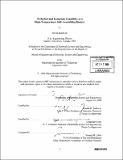| dc.contributor.advisor | Donald R. Sadoway and Gerbrand Ceder. | en_US |
| dc.contributor.author | Bradwell, David (David Johnathon) | en_US |
| dc.contributor.other | Massachusetts Institute of Technology. Dept. of Materials Science and Engineering. | en_US |
| dc.date.accessioned | 2007-06-28T12:22:47Z | |
| dc.date.available | 2007-06-28T12:22:47Z | |
| dc.date.copyright | 2006 | en_US |
| dc.date.issued | 2006 | en_US |
| dc.identifier.uri | http://hdl.handle.net/1721.1/37683 | |
| dc.description | Thesis (M. Eng.)--Massachusetts Institute of Technology, Dept. of Materials Science and Engineering, 2006. | en_US |
| dc.description | Includes bibliographical references (p. 131-135). | en_US |
| dc.description.abstract | A conceptual high-temperature battery system for large-scale grid power applications was proposed, described, and evaluated. Unlike conventional battery technologies whose maximum current rate is constrained by at least one solid phase, the novel three-layer liquid-phase electrode-electrolyte-electrode cell facilitates high diffusivity and facile interfacial kinetics, which results in rapid ion transport and low activation overpotential. In addition to the extremely high currents enabled by the absence of solid-liquid interfaces, this cell configuration represents a robust design that can be easily manufactured. The molten components will self assemble due to their immiscibility and different densities. Another key feature is that a molten metalloid acts as the positive electrode, while an alkali or alkaline earth metal acts as the negative electrode, providing two electronically conductive molten electrodes. The cell is estimated to have a lifespan of 10-15 years with >3,000 deep-discharge cycles, to require minimal maintenance, and to supply 1-5 A/cm2 at 0.9 V with 80% DC-DC cycle-efficiency. | en_US |
| dc.description.abstract | (cont.) One embodiment comprising electrodes of magnesium (negative) and antimony (positive) and a molten sulfide supporting electrolyte served as the basis for a detailed feasibility assessment (alternative electrode and electrolyte materials were also discussed). A cost model was created based on an entire battery system, which included top and bottom current collectors, a corrosion resistant sheath, insulation, and other components. Materials were selected based on corrosion resistance, mechanical stability at the operation temperature, and cost. A DC-battery was estimated to cost $35-60/kWh. An AC-compatible system would also require power electronics, at an additional cost of $50/kWh. With a 50% gross margin on the battery unit, the price of an AC-system was estimated to be $120-170/kWh. Market analysis was performed to assess the commercial viability of a large-scale electricity storage device. A stand-alone, load-leveling device was found to generate minimal revenue, while a system for transmission-line and distribution-system upgrade deferral was found to be a much more attractive proposition. | en_US |
| dc.description.abstract | (cont.) System requirements for this application include 75% AC-AC cycle-efficiency, >1 MW capacity, 8-hour discharge duration, re-locatable, a footprint <100 m2/MW, and a 10-15 year lifespan. Extensive market penetration would occur with a price of $150/kWh, which is achievable by the proposed system. Support for intermittent renewables is possible under circumstances where they contribute to more than 10% of the grid power. | en_US |
| dc.description.statementofresponsibility | by David Bradwell. | en_US |
| dc.format.extent | 136 p. | en_US |
| dc.language.iso | eng | en_US |
| dc.publisher | Massachusetts Institute of Technology | en_US |
| dc.rights | M.I.T. theses are protected by copyright. They may be viewed from this source for any purpose, but reproduction or distribution in any format is prohibited without written permission. See provided URL for inquiries about permission. | en_US |
| dc.rights.uri | http://dspace.mit.edu/handle/1721.1/7582 | |
| dc.subject | Materials Science and Engineering. | en_US |
| dc.title | Technical and economic feasibility of a high-temperature self-assembling battery | en_US |
| dc.type | Thesis | en_US |
| dc.description.degree | M.Eng. | en_US |
| dc.contributor.department | Massachusetts Institute of Technology. Department of Materials Science and Engineering | |
| dc.identifier.oclc | 127121394 | en_US |
